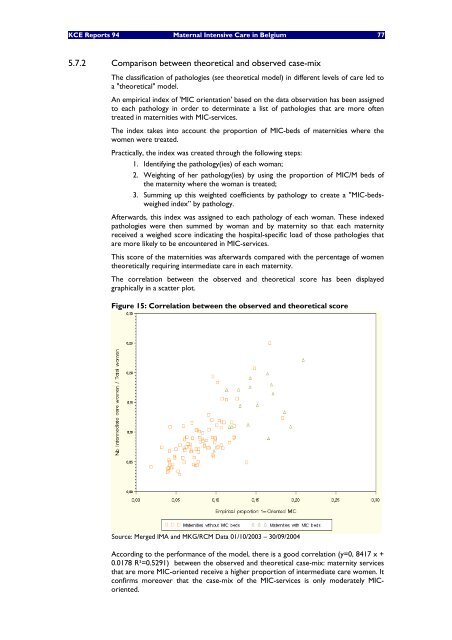Soins maternels intensifs (Maternal Intensive Care) en Belgique - KCE
Soins maternels intensifs (Maternal Intensive Care) en Belgique - KCE
Soins maternels intensifs (Maternal Intensive Care) en Belgique - KCE
You also want an ePaper? Increase the reach of your titles
YUMPU automatically turns print PDFs into web optimized ePapers that Google loves.
<strong>KCE</strong> Reports 94 <strong>Maternal</strong> <strong>Int<strong>en</strong>sive</strong> <strong>Care</strong> in Belgium 77<br />
5.7.2 Comparison betwe<strong>en</strong> theoretical and observed case-mix<br />
The classification of pathologies (see theoretical model) in differ<strong>en</strong>t levels of care led to<br />
a "theoretical" model.<br />
An empirical index of 'MIC ori<strong>en</strong>tation' based on the data observation has be<strong>en</strong> assigned<br />
to each pathology in order to determinate a list of pathologies that are more oft<strong>en</strong><br />
treated in maternities with MIC-services.<br />
The index takes into account the proportion of MIC-beds of maternities where the<br />
wom<strong>en</strong> were treated.<br />
Practically, the index was created through the following steps:<br />
1. Id<strong>en</strong>tifying the pathology(ies) of each woman;<br />
2. Weighting of her pathology(ies) by using the proportion of MIC/M beds of<br />
the maternity where the woman is treated;<br />
3. Summing up this weighted coeffici<strong>en</strong>ts by pathology to create a "MIC-bedsweighed<br />
index” by pathology.<br />
Afterwards, this index was assigned to each pathology of each woman. These indexed<br />
pathologies were th<strong>en</strong> summed by woman and by maternity so that each maternity<br />
received a weighed score indicating the hospital-specific load of those pathologies that<br />
are more likely to be <strong>en</strong>countered in MIC-services.<br />
This score of the maternities was afterwards compared with the perc<strong>en</strong>tage of wom<strong>en</strong><br />
theoretically requiring intermediate care in each maternity.<br />
The correlation betwe<strong>en</strong> the observed and theoretical score has be<strong>en</strong> displayed<br />
graphically in a scatter plot.<br />
Figure 15: Correlation betwe<strong>en</strong> the observed and theoretical score<br />
Source: Merged IMA and MKG/RCM Data 01/10/2003 – 30/09/2004<br />
According to the performance of the model, there is a good correlation (y=0, 8417 x +<br />
0.0178 R²=0.5291) betwe<strong>en</strong> the observed and theoretical case-mix: maternity services<br />
that are more MIC-ori<strong>en</strong>ted receive a higher proportion of intermediate care wom<strong>en</strong>. It<br />
confirms moreover that the case-mix of the MIC-services is only moderately MICori<strong>en</strong>ted.

















